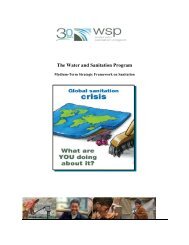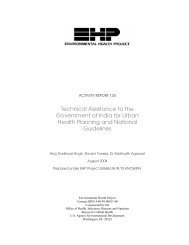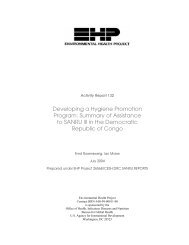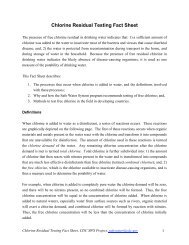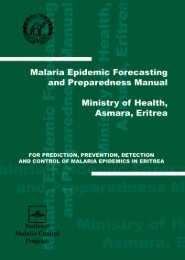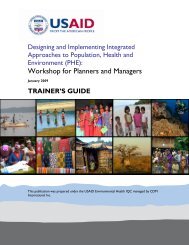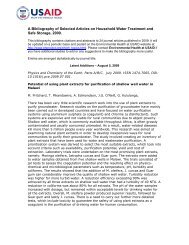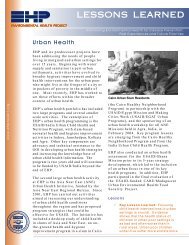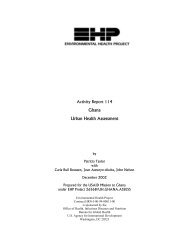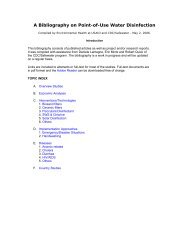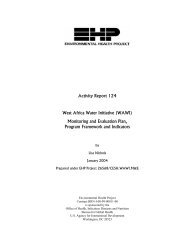Changing Glaciers and Hydrology in Asia - Environmental Health at ...
Changing Glaciers and Hydrology in Asia - Environmental Health at ...
Changing Glaciers and Hydrology in Asia - Environmental Health at ...
- No tags were found...
Create successful ePaper yourself
Turn your PDF publications into a flip-book with our unique Google optimized e-Paper software.
SECTION 6CONCLUSIONSThe review of scientific <strong>in</strong>form<strong>at</strong>ion about glacier melt <strong>in</strong> High <strong>Asia</strong> revealed, first <strong>and</strong> foremost,a lack of d<strong>at</strong>a <strong>and</strong> <strong>in</strong>form<strong>at</strong>ion, a lack th<strong>at</strong> hampers <strong>at</strong>tempts to project likely impacts <strong>and</strong> takeaction to adapt to changed conditions. Known near-term impacts <strong>in</strong>clude the <strong>in</strong>creas<strong>in</strong>gpotential for GLOFs <strong>and</strong> the disappearance of small glaciers, especially <strong>at</strong> lower l<strong>at</strong>itudes.Underst<strong>and</strong><strong>in</strong>g th<strong>at</strong> glacier melt/retre<strong>at</strong>, although occurr<strong>in</strong>g <strong>at</strong> <strong>in</strong>creas<strong>in</strong>g r<strong>at</strong>es, is not likely toproduce widespread disastrous impacts <strong>in</strong> the next decade or two means th<strong>at</strong> societies havetime to build their resilience to changes <strong>in</strong> the amount of w<strong>at</strong>er available <strong>and</strong> when it arrivesdur<strong>in</strong>g the year. However, exist<strong>in</strong>g vulnerabilities <strong>in</strong> human health st<strong>at</strong>us, popul<strong>at</strong>ion pressure,degraded ecosystems <strong>and</strong> – especially – w<strong>at</strong>er stress make societies <strong>and</strong> ecosystems vulnerableto any changes <strong>in</strong> w<strong>at</strong>er availability as glacier melt acceler<strong>at</strong>es <strong>in</strong> the com<strong>in</strong>g decades.As a result of this analysis, the program conceptsdeveloped <strong>in</strong> consult<strong>at</strong>ion with USAID addressedthree different elements: the challenge of lack of<strong>in</strong>form<strong>at</strong>ion, vulnerabilities rel<strong>at</strong>ed to currentsocietal <strong>and</strong> ecosystem conditions, <strong>and</strong> the need formitig<strong>at</strong>ion, focus<strong>in</strong>g on black carbon. These programconcepts represent “no regrets’ activities, mean<strong>in</strong>gth<strong>at</strong> they address critical needs, however the glaciersrespond to clim<strong>at</strong>e change.The multi-faceted analysis presented here leads toconclusions (listed <strong>in</strong> italics) about the characteristicsof programs th<strong>at</strong> are likely to be effective <strong>in</strong>address<strong>in</strong>g glacier melt <strong>and</strong> its impacts:“The comb<strong>in</strong>ed w<strong>at</strong>er resources of the gre<strong>at</strong>erHimalayan region are immense, almost beyondcomprehension. Consequently, the need forappropri<strong>at</strong>e <strong>and</strong> efficient management cannot beexagger<strong>at</strong>ed. Not only the economic stability ofseveral of the <strong>in</strong>dividual countries <strong>in</strong> the region,but the very well-be<strong>in</strong>g of many hundred millionpeople, depend on rapid progress towardappropri<strong>at</strong>e management.”Jack Ives, 2006As glacier melt is part of complex, region-wide hydrologic changes th<strong>at</strong> are happen<strong>in</strong>g as a result ofclim<strong>at</strong>e change, effective programs to address glacier melt will be cross-sectoral <strong>and</strong> will achieve cobenefitsacross sectors.Below are examples of benefits th<strong>at</strong> can be part of co-benefit streams:1. Improved health outcomes (from healthier ecosystems, reduced pollution, improvedsanit<strong>at</strong>ion, more efficient w<strong>at</strong>er use);2. Reduced fertility <strong>and</strong> eas<strong>in</strong>g of popul<strong>at</strong>ion pressures (by meet<strong>in</strong>g family plann<strong>in</strong>g needs);3. Strengthened governance <strong>in</strong>stitutions (through environmental, agricultural, <strong>and</strong> forestrymanagement; development of n<strong>at</strong>ional <strong>and</strong> local policies; establishment <strong>and</strong>empowerment of local resource user groups);71



